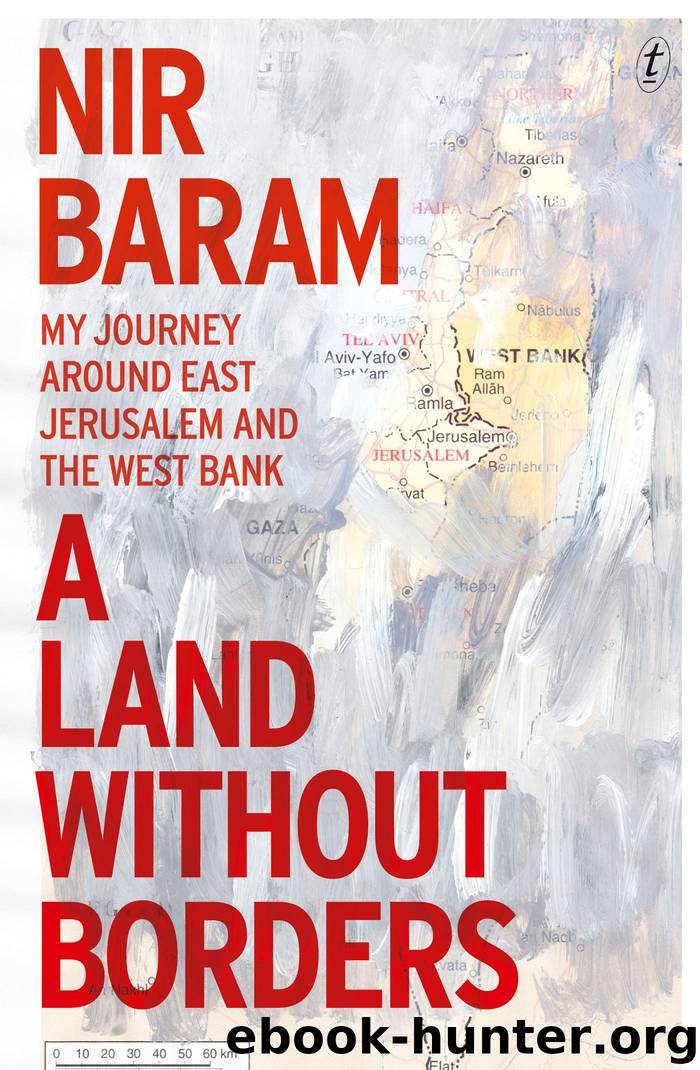A Land Without Borders by Nir Baram

Author:Nir Baram
Language: eng
Format: epub
Publisher: The Text Publishing Company
Published: 2016-11-11T05:00:00+00:00
7
The Closest Thing to Hell
Palestinian Jerusalem beyond the Separation Wall
The couches in the small living room have a delicate pattern in their green upholstery, and those in the large living room are maroon. Well-dressed boys and girls run around, stopping to shake my hand or nod hello. A pretty little girl wearing a light pink hat looks out of the window, indifferent to the attention lavished upon her. Leila, the forty-five-year-old matriarch of the family, sits in the middle of the couch, flanked by her daughters: twenty-four-year-old Wala, with a baby on her lap, and twenty-year-old Ayah, who inches her way to the far end of the couch. Leila’s husband Ismail sits opposite them with his ten-year-old daughter and six-year-old granddaughter perched on the arms of his chair. Everyone is looking at him.
“When I’m at home—and I almost never leave home—sometimes I forget,” says Wala as she strokes her baby, “‘because the house is beautiful and neat and we’ve invested so much in it.”
“You forget?”
“I forget that this place is a satanic invention. The closest thing to hell.”
* * *
Far away on the horizon you can see a sort of miniature Manhattan: lots of white stone buildings of different heights, slanted roofs in various shapes, red tiles. Only when you get closer do you notice the gray wall. I ask Jamil Sanduka, a professional snake-catcher and the head of Ras Khamis’s neighborhood committee, how much an apartment costs here. “One hundred and sixty thousand shekels (US$42,000) will get you a thirteen-hundred-square-foot apartment, including a new kitchen, anything you want,” he says.
Ras Khamis and Ras Shehada are two adjacent neighborhoods in northeastern Jerusalem, not far from the predominantly Jewish neighborhood of French Hill. Like the nearby refugee camp of Shuafat, they have been located within Jerusalem’s municipal borders since 1967, and most of their residents have blue identity cards—meaning they are permanent residents but not citizens of Israel. In the middle of the last decade, their lives were transformed when the so-called “security fence” was constructed, separating them from the rest of Jerusalem. Now, when residents want to pray on the Temple Mount, visit family in the Old City, work in the center of town, or seek medical treatment, they must go through the Shuafat checkpoint.
The wall surrounded these neighborhoods with a tight band, trapping their residents in a no-man’s-land that lacks any clear authority. In effect, Israel created a new Palestinian domain here, the likes of which had never been seen before. The Palestinian Authority is not allowed to enter the neighborhoods because they are under Israeli sovereignty, but most Israeli officials don’t venture over the wall to the Palestinian side, which is ostensibly connected to the West Bank. The people who live here are residents of Jerusalem, though there is no evidence of any municipal authorities: the city does not remove trash, rarely repairs or paves roads, and doesn’t handle the sewage. If your home is burgled, there’s no chance the police will respond; if you have a heart attack, don’t bother waiting for an Israeli ambulance.
Download
This site does not store any files on its server. We only index and link to content provided by other sites. Please contact the content providers to delete copyright contents if any and email us, we'll remove relevant links or contents immediately.
How to Read Water: Clues and Patterns from Puddles to the Sea (Natural Navigation) by Tristan Gooley(3410)
Full Circle by Michael Palin(3393)
Into Thin Air by Jon Krakauer(3315)
How to Read Nature by Tristan Gooley(3253)
In Patagonia by Bruce Chatwin(2877)
The Lost Art of Reading Nature's Signs by Tristan Gooley(2625)
A Thousand Splendid Suns by Khaled Hosseini(2620)
Don't Sleep, There Are Snakes by Daniel L. Everett(2578)
Venice by Jan Morris(2527)
City of Djinns: a year in Delhi by William Dalrymple(2516)
The Songlines by Bruce Chatwin(2499)
The Queen of Nothing by Holly Black(2499)
L'Appart by David Lebovitz(2488)
The Big Twitch by Sean Dooley(2394)
Tokyo Geek's Guide: Manga, Anime, Gaming, Cosplay, Toys, Idols & More - The Ultimate Guide to Japan's Otaku Culture by Simone Gianni(2316)
Come, Tell Me How You Live by Mallowan Agatha Christie(2212)
Iranian Rappers And Persian Porn by Maslin Jamie(2159)
INTO THE WILD by Jon Krakauer(2158)
A TIME OF GIFTS by Patrick Leigh Fermor(2156)
